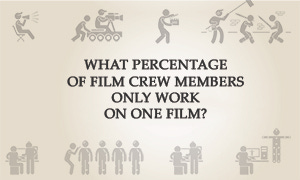What percentage of film crew members only work on one film?
Many outsiders to the movie industry would regard the chance to be part of the crew making a movie as a once in a lifetime experience. Little do they know, for the majority of people who actually get that chance, it quite literally is!
I have written before about how only about a third of writers, producers and directors get the chance to make a second film. Today, I am answering a question from a reader who got in touch to ask how frequent mono-credits are in other jobs and departments.
To answer this question, I looked at the movie careers of 507,516 people who had at least one crew credit on a movie released in US cinemas between 2000 and 2019. There is more detail on my criteria and methodology at the end of the article.
How many people receive just one credit?
Let's start by looking at key creatives and then move on to other jobs and departments.
Film composers are least likely to be hired more than once, with 70% only receiving one movie credit. They're followed closely by set decorators (67%), directors (67%), writers (67%) and producers (66%). Casting directors have the highest levels of recidivism, but even they have a 55% one-and-done rate.
Let's widen out to the whole crew, looking at the different departments. In line with what we saw above, people working in the music department are the least likely to work in film again, with 65% only receiving one credit. At the other end of the spectrum is the visual effects department, where just under two thirds of people receive two or more credits.
It's worth reminding ourselves that this research is looking at films which made it to US cinemas. I.e. they were funded, finished and distributed. Only a few percent of the films made in the world manage to get this far. But despite being among the more successful titles, the majority of their crew (51.4%) will not work on another movie.
Average number of movie credits
Using the same data we can look at a related question - how many credits does the average person receive throughout their career?
Casting Directors have the highest, with an average of 4.7 movie credits per person. At the other end we see writers (1.8), directors (1.8) and producers (2.3).
Crew members in the visual effects department have the greatest number of credits per person (7.1) This is measuring publicly declared credits so I suspect the real number is slightly higher, given that studios are notoriously patchy in ensuring that everyone who worked on a movie's visual effects receives a name check.
Notes
Today's research looks at the movie credits of people who had at least one crew credit in a movie released theatrically in North America between 1st January 2000 and 31st December 2019. Once I had my list of people, I went back and looked at all their movie credits, even those released before 2000, in order to ensure I was assessing their career to date.
Raw credit data came from a number of public sources, including IMDB, Wikipedia and Movie Insider.
This does not take into account work in other mediums, such as TV, music videos, online videos, etc.
This research treats all credits the same as it cannot take account of the length of time worked, seniority, the amount paid, etc. Given the unbalanced nature of the industry, it's certainly possible to be successful in ways which do not show up in simple credits counts. These include being the writer of unproduced (but optioned) scripts, being hired infrequently but paid handsomely, uncredited work, etc.







